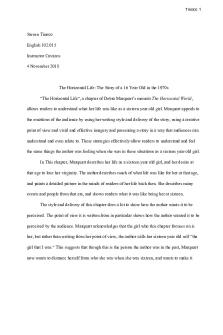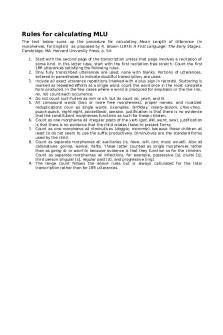Textual Analysis - Mrs\'s Browns Boys PDF

| Title | Textual Analysis - Mrs\'s Browns Boys |
|---|---|
| Author | Max Ruddock |
| Course | Analysing Film |
| Institution | University of East Anglia |
| Pages | 2 |
| File Size | 71 KB |
| File Type | |
| Total Downloads | 55 |
| Total Views | 158 |
Summary
Essay discussing Mrs Brown's boys and how it is created...
Description
How$does$the$text$construct$meaning?$ For$ my$ answer,$ I$ will$ be$ referring$ to$ the$ text:$ ‘Mrs$ Brown’s$ Boys,$ ‘New$ Mammy’’$ (First$aired$on:$BBC1,$06B02B12).$ The$text$opens$with$a$cartoon$graphic$showing$a$garden$with$a$hanging$washing$line$ running$ through.$ We$ see$ a$ seemingly$ old$ depiction$ of$ a$ cartoon$ character$ moving$ across$the$frame$from$left$to$right,$pinning$up$cartoon$paper$faces$amidst$a$selection$ of$socks.$The$quick$movement$of$the$character’s$arms$lifting$and$retracting$help$to$ build$ a$ pace$ which$ alongside$ a$ very$upbeat,$ almost$ keyboardBsampled$ soundtrack,$ helps$to$ set$the$tone$ for$the$ text$and$implies$a$comedic$ nature.$This$ suggestion$of$ comedy$ is$also$ added$ to$by$ the$ fact$that$ the$ small$ bird$sitting$ on$ the$washing$ line$ defecates$as$ the$main$ titles$appear.$ The$graphic$ is$also$ lacking$in$ colour$tones$ and$ instead$relies$on$ very$childBlike$block$colours,$which$again$reinforces$the$simplistic,$ straightforward$idea$of$simple$to$read$television$entertainment.$ We$see$in$the$background$of$the$shot,$a$man$fast$asleep$on$a$deckchair,$reinforcing$a$ certain$ideology$ of$stereotypical$ gender$values$(men$ are$lazy$ and$do$not$ help$with$ domestic$chores),$and$suggests$how$male$characters$may$conform$in$the$entirety$of$ the$ text$ itself.$ A$ viewer$ may$ disagree$ with$ this$ representation,$ but$ Butler$ argues$ that:$“We$rely$upon$the$consistency$of$characters$and$space;$it$is$part$of$what$makes$ the$ show$ comfortable$ to$ watch.”1$ What$ he$ is$ suggesting$ here$ is$ that$ we$ require$ characters$in$television$ to$provide$consistent$personalities,$ and$I$would$add$ that$in$ particular$for$comedy,$we$require$characters$to$not$develop$or$change$meticulously$ from$ their$ general$ personal$ traits$ e.g.$ (Friends$ 1994?2004)$ Joey’s$ obsession$ with$ food,$(The$Big$Bang$Theory$2007?)$Sheldon’s$social$ignorance.$$ As$ we$ move$ from$ this$ shot$ to$ a$ live$ action$ pan,$ a$ studio$ environment$ is$ revealed$ with$a$live$audience.$As$a$viewer,$this$suggests$that$we$are$watching$the$programme$ with$ the$ audience,$ as$ the$ laughter$ track$ is$ included,$ highlighting$ points$ of$ comedy$ for$ the$ reader.$ This$ pan$ jump$ cuts$ to$ another$ pan$ of$ a$ traditional$ home$ environment,$culminating$in$a$mid$shot$of$an$old$(60+)$male$slumped$in$an$armchair$ watching$ the$TV$ set$ that$is$ framed$ in$the$ lower$ right$ of$the$ screen.$ The$title$ ‘New$ Mammy’$ fades$ in$ and$ out$ over$ this$ pan;$ none$ of$ the$ letters$ are$ in$ line$ suggesting$ informality$and$providing$reassurance$to$the$audience$that$this$is$an$entertainment$ text.$$ A$door$knocking$is$heard$and$the$male$shouts$‘Door!’$twice;$on$the$second$switching$ to$a$medium$closeBup$of$his$face.$The$use$of$switching$to$a$more$intimate$shot,$firstly$ allows$ the$viewer$ to$ attach$a$ level$ of$ significance$to$ his$ command$ for$someone$ to$ answer$the$door,$and$secondly,$to$allow$the$viewer$to$see$his$face$from$a$very$blunt$ perspective$so$they$can$psychologically$attach$the$ignorance$that$he$is$portraying$to$ the$ character$ in$ his$ entirety.$ Irony$ is$ added$ here$ as$ we$ jump$ cut$ to$ a$ shot$ of$ a$ woman$entering$another$door,$suggesting$that$the$problem$the$man$has$raised$has$ now$ been$ resolved.$ However,$ the$ knocking$ continues$ and$ the$ woman$ enters$ the$ same$ room/shot$ as$ the$ man,$ albeit$ in$ the$ background,$ meaning$ that$ spacial$
connection$is$engaged$between$ the$two$characters$and$we$ realise$the$woman$was$ not$the$one$knocking$at$the$door.$ As$stated$before,$the$meaning$of$this$text$is$constructed$primarily$through$the$very$ stark,$ outspoken$ personalities$ of$ the$ characters,$ which$ is$ emphasised$ through$ the$ use$of$narrative,$sound$and$camera$work.$Many$of$these$traits$actually$help$to$shape$ the$ narrative$structure$ or$ story$arc$ of$ an$episode,$ as$ we$see$ how$ other$characters$ react$towards$this.$ $ Bibliography:$ $ ‘Mrs$Brown’s$Boys,$‘New$Mammy’’$(First$aired$on:$BBC1,$06B02B12).$ $ ‘Friends’$(NBC$1994B2004)$ $ ‘The$Big$Bang$Theory’$(CBS$2007B)$ $ 1 Butler,$Jeremy$G.$2011,$Television$:$Critical$Methods$and$Applications,$page$34.$...
Similar Free PDFs

Textual Analysis
- 3 Pages

Textual Analysis
- 2 Pages

Textual Analysis - Podcast
- 3 Pages

Textual Analysis Exercise
- 3 Pages

Perez Hilton Textual Analysis
- 16 Pages

Textual Analysis Outline
- 4 Pages

The Crito - Textual Analysis
- 5 Pages

Sitcom Textual Analysis
- 2 Pages

CYB103 Textual analysis
- 7 Pages

Textual Rhetorical Analysis
- 3 Pages

Browns Stages Morphemes Summary
- 1 Pages

Browns Rules for Calculating MLU
- 1 Pages
Popular Institutions
- Tinajero National High School - Annex
- Politeknik Caltex Riau
- Yokohama City University
- SGT University
- University of Al-Qadisiyah
- Divine Word College of Vigan
- Techniek College Rotterdam
- Universidade de Santiago
- Universiti Teknologi MARA Cawangan Johor Kampus Pasir Gudang
- Poltekkes Kemenkes Yogyakarta
- Baguio City National High School
- Colegio san marcos
- preparatoria uno
- Centro de Bachillerato Tecnológico Industrial y de Servicios No. 107
- Dalian Maritime University
- Quang Trung Secondary School
- Colegio Tecnológico en Informática
- Corporación Regional de Educación Superior
- Grupo CEDVA
- Dar Al Uloom University
- Centro de Estudios Preuniversitarios de la Universidad Nacional de Ingeniería
- 上智大学
- Aakash International School, Nuna Majara
- San Felipe Neri Catholic School
- Kang Chiao International School - New Taipei City
- Misamis Occidental National High School
- Institución Educativa Escuela Normal Juan Ladrilleros
- Kolehiyo ng Pantukan
- Batanes State College
- Instituto Continental
- Sekolah Menengah Kejuruan Kesehatan Kaltara (Tarakan)
- Colegio de La Inmaculada Concepcion - Cebu



